|

User's Guide
|
|
Printing / Various Printing Options
Double-Sided Printing
 Standard double-sided printing for Windows
Standard double-sided printing for Windows
 Folded booklet double-sided printing for Windows
Folded booklet double-sided printing for Windows
There are two types of double-sided printing available. Standard double-sided printing allows you to print the odd-numbered pages first. Once these pages are printed, they can be reloaded to print the even-numbered pages onto the opposite side of the paper.
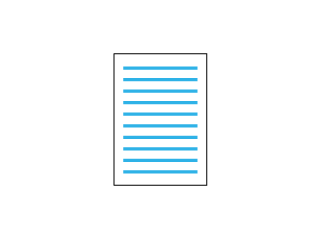
Folded booklet double-sided printing allows you to make single-fold booklets. To create it, the pages that appear on the outside (after the page is folded) are printed first. The pages that will appear inside the booklet can then be printed after the paper is reloaded into the back tray as shown in the illustration below.
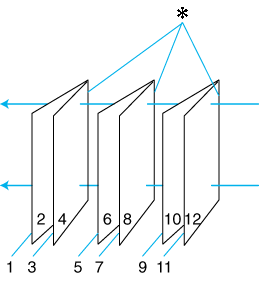
|
|
|
Single-fold booklet |
 |
 : Binding edge : Binding edge
|
A booklet can be created by printing pages 1 and 4 on the first sheet of paper, pages 5 and 8 on the second sheet of paper, and pages 9 and 12 on the third sheet of paper. After these sheets are reloaded into the back tray, you can then print pages 2 and 3 on the back of the first sheet of paper, pages 6 and 7 on the back of the second sheet of paper, and pages 10 and 11 on the back of the third sheet of paper. The resulting pages can then be folded and bound together into a booklet.
 |
Note:
|
 | -
This feature is not available with Macintosh.
|
|
 | -
This feature is not available when selecting the Borderless check box on the Main menu (Windows).
|
|
 | -
Paper cannot be loaded into the front tray when using this feature. Load into the back tray.
|
|
 | -
This feature is not available when this product is accessed over a network or is used as a shared printer.
|
|
 | -
Depending on the media type, stacks of up to 30 sheets can be loaded into the back tray during double-sided printing.
|
|
 | -
Only use media types that are suitable for double-sided printing. Otherwise, the printout quality may deteriorate.
|
|
 | -
Depending on the media type and the amount of ink used to print text and images, ink may bleed through to the other side of the paper.
|
|
 | -
The surface of the paper may be smeared during double-sided printing.
|
|
Standard double-sided printing for Windows
Follow the steps below to print odd- and even-numbered pages onto opposite sides of the sheet.
 |
Access the printer driver.
|
 |
Click the Main tab, then select one of the Quality Options recommended below. For details of other Quality Options, see online help.
|
-
Draft for rough drafts with reduced print quality
-
Text for text-only documents with higher text quality
-
Text & Image for higher quality documents with text and images
-
Photo for good quality and speed
-
Best Photo for the best print quality
 |
Select Automatic or Back as the Source setting.
|
 |
Select the paper type loaded in the tray as the Type setting.
|
 |
Select the paper size of your file as the Size setting. You can also define a custom paper size. For details, see the following section.
|
 |
Select Portrait (tall) or Landscape (wide) to change the orientation of your printout.
|
 |  |
Note:
|
 |  | |
For more print settings, click Advanced. Click Help for more information.
|
|
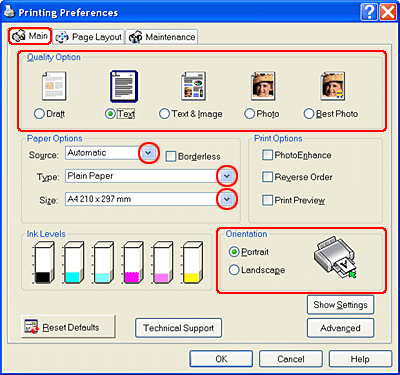
 |
Click the Page Layout tab, then select the Double-Sided Printing check box.
|
 |
Click Margins to open the Margins dialog box.
|
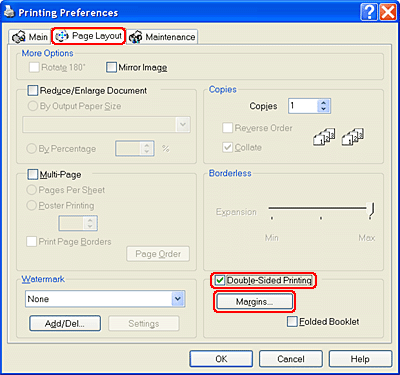
 |
Specify the edge of the paper where the binding will be placed. You can choose Left, Top, or Right.
|
 |
Choose cm or inch as the Unit setting. Then, specify the width of the binding margin. You can enter any width from 0.3 cm to 3.0 cm, or from 0.12 inches to 1.18 inches.
|
 |  |
Note:
|
 |  | |
The actual binding margin may be different from the specified settings depending on your application. Experiment with a few sheets to examine actual results before printing the entire job.
|
|
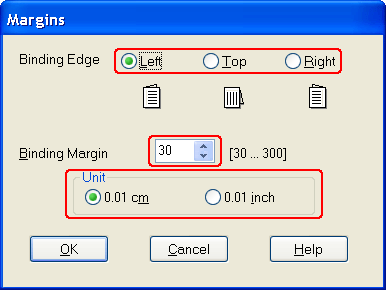
 |
Click OK to return to the Page Layout menu. Then, click OK to save your settings.
|
 |
Load paper into the back tray, then send the print job from your application. Instructions for generating the even-numbered pages will be displayed while the odd-numbered pages are printed.
|
 |
Follow the on-screen instructions to reload the paper.
|
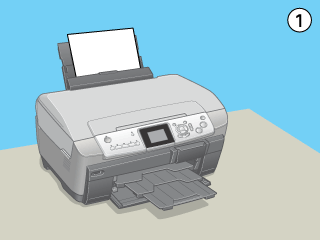
 |  |
Note:
|
 |  | -
The paper may curl during printing due to the amount of ink used. Should this occur, slightly curl the sheets in the opposite direction before reloading them into the back tray.
|
|
 |  | -
Align the sheet stack by tapping its edges against a hard, flat surface before reloading the stack into the back tray.
|
|
 |  | -
Follow the instructions provided when reloading the printouts. Paper jams or improperly placed binding margins may occur if the printouts are not reloaded correctly.
|
|
 |
Once the paper is reloaded, click Resume to print the even-numbered pages.
|

[Top]
Folded booklet double-sided printing for Windows
Use the following steps to create a folded booklet as described in the beginning of this section.
 |
Access the printer driver.
|
 |
Click the Main tab, then select one of the Quality Options recommended below. For details of other Quality Options, see online help.
|
-
Draft for rough drafts with reduced print quality
-
Text for text-only documents with higher text quality
-
Text & Image for higher quality documents with text and images
-
Photo for good quality and speed
-
Best Photo for the best print quality
 |
Select Automatic or Back as the Source setting.
|
 |
Select the paper type loaded in the tray as the Type setting.
|
 |
Select the paper size of your file as the Size setting. You can also define a custom paper size. For details, see the following section.
|
 |
Select Portrait (tall) or Landscape (wide) to change the orientation of your printout.
|
 |  |
Note:
|
 |  | |
For more print settings, click Advanced. Click Help for more information.
|
|
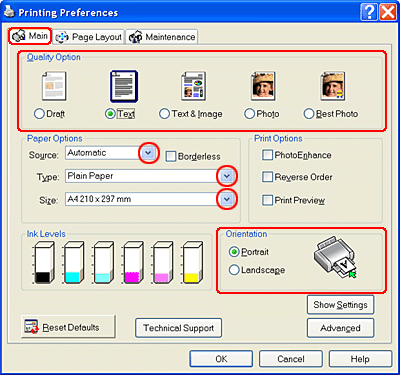
 |
Click the Page Layout tab and select the Double-Sided Printing check box. Then, select the Folded Booklet check box.
|
 |
Click Margins to open the Margins dialog box.
|
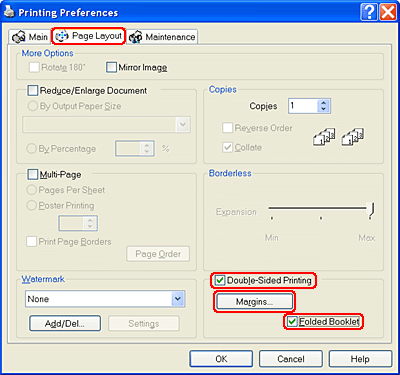
 |
Specify the edge of the paper where the binding will be placed. You can choose Left, Top, or Right.
|
 |  |
Note:
|
 |  | |
When Portrait is selected as the Orientation setting on the Main menu, the Left or Right binding positions are available. The Top binding position is available when Landscape is selected as the Orientation setting.
|
|
 |
Choose cm or inch as the Unit setting. Specify the width of the binding margin. You can enter any width from 0.3 cm to 3.0 cm, or from 0.12 inches to 1.18 inches. The specified margin width will be used on both sides of the fold. For example, if a 1 cm margin is specified, a 2 cm margin will be inserted (a margin of 1 cm will be placed on each side of the fold).
|
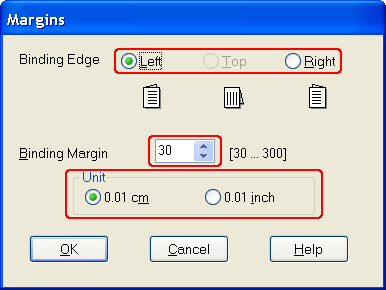
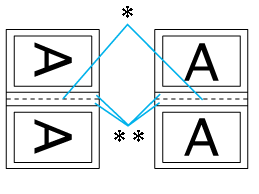
|
|
Portrait |
Landscape |
 |
 : Folding edge : Folding edge
|
 |
Click OK to return to the Page Layout menu. Then, click OK to save your settings.
|
 |
Load paper into the back tray, then send the print job from your application. Instructions for printing the inside pages will be displayed while the outside pages are printed.
|
 |
Follow the on-screen instructions to reload the paper.
|

 |  |
Note:
|
 |  | -
The paper may curl during printing due to the amount of ink used. Should this occur, slightly curl the sheets in the opposite direction before reloading them into this product.
|
|
 |  | -
Align the sheet stack by tapping its edges against a hard, flat surface before reloading the stack into this product.
|
|
 |  | -
Follow the instructions provided when reloading the printouts. Paper jams or improperly placed binding margins may occur if the printouts are not reloaded correctly.
|
|
 |
Once the paper is reloaded, click Resume to print the inside pages.
|
 |
Once printing is complete, fold the sheets and bind them together using a stapler or other binding method.
|

[Top]
| Version NPD1043-00, Copyright © 2005, SEIKO EPSON CORPORATION |
Standard double-sided printing for Windows
Folded booklet double-sided printing for Windows